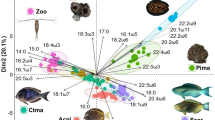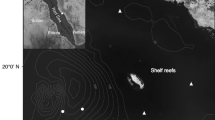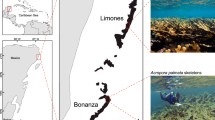Abstract
Five hundred and ninety-nine primary producers and consumers in the Papahānaumokuākea Marine National Monument (PMNM) (22°N–30°N, 160°W–180°W) were sampled for carbon and nitrogen stable isotope composition to elucidate trophic relationships in a relatively unimpacted, apex predator–dominated coral reef ecosystem. A one-isotope (δ13C), two-source (phytoplankton and benthic primary production) mixing model provided evidence for an average minimum benthic primary production contribution of 65 % to consumer production. Primary producer δ15N values ranged from −1.6 to 8.0 ‰ with an average (2.1 ‰) consistent with a prevalence of N2 fixation. Consumer group δ15N means ranged from 6.6 ‰ (herbivore) to 12.1 ‰ (Galeocerdo cuvier), and differences between consumer group δ15N values suggest an average trophic enrichment factor of 1.8 ‰ Δ15N. Based on relative δ15N values, the larger G. cuvier may feed at a trophic position above other apex predators. The results provide baseline data for investigating the trophic ecology of healthy coral reef ecosystems.








Similar content being viewed by others
Abbreviations
- BMA:
-
Benthic macroalgae
- BMI:
-
Benthic microalgae
- C:
-
Carbon
- FL:
-
Fork length
- FFS:
-
French Frigate Shoals
- HCl:
-
Hydrochloric acid
- IRMS:
-
Isotope ratio mass spectrometer
- Lu:
-
Ludox
- PMNM:
-
Papahānaumokuākea Marine National Monument
- N:
-
Nitrogen
- SD:
-
Standard deviation
- SI:
-
Stable isotope
- TEF:
-
Trophic enrichment factor
- TL:
-
Total length
- TP:
-
Trophic position
- VM:
-
Vertical migration
References
Allen GR, Steene R, Allen M (1998) A guide to angelfishes and butterflyfishes. Odyssey Publishing/Tropical Reef Research, Perth
Atkinson MJ, Grigg RW (1984) Model of a coral-reef ecosystem. 2. Gross and net benthic primary production at French Frigate Shoals, Hawaii. Coral Reefs 3:13–22. doi:10.1007/bf00306136
Bearhop S, Adams CE, Waldron S, Fuller RA, Macleod H (2004) Determining trophic niche width: a novel approach using stable isotope analysis. J Anim Ecol 73:1007–1012. doi: 10.1111/j.0021-8790.2004.00861.x
Bond AL, Diamond AW (2011) Recent Bayesian stable-isotope mixing models are highly sensitive to variation in discrimination factors. Ecol Appl 21:1017–1023. doi:10.1890/09-2409.1
Bozec YM, Gascuel D, Kulbicki M (2004) Trophic model of lagoonal communities in a large open atoll (Ouvea, Loyalty islands, New Caledonia). Aquat Living Resour 17:151–162. doi:10.1051/alr:2004024
Carassou L, Kulbicki M, Nicola TJR, Polunin NVC (2008) Assessment of fish trophic status and relationships by stable isotope data in the coral reef lagoon of New Caledonia, southwest Pacific. Aquat Living Resour 21:1–12. doi:10.1051/alr:2008017
Carpenter EJ, Harvey HR, Fry B, Capone DG (1997) Biogeochemical tracers of the marine cyanobacterium Trichodesmium. Deep-Sea Res, Part I 44:27–38. doi:10.1016/s0967-0637(96)00091-x
Caut S, Angulo E, Courchamp F (2009) Variation in discrimination factors δ15N and δ13C: the effect of diet isotopic values and applications for diet reconstruction. J Appl Ecol 46:443–453. doi:10.1111/j.1365-2664.2009.01620.x
Cruz-Rivera E, Paul VJ (2006) Feeding by coral reef mesograzers: algae or cyanobacteria? Coral Reefs 25:617–627. doi:10.1007/s00338-006-0134-5
Currin CA, Levin LA, Talley TS, Michener R, Talley D (2011) The role of cyanobacteria in Southern California salt marsh food webs. Mar Ecol 32:346–363. doi:10.1111/j.1439-0485.2011.00476.x
Dale JJ, Meyer CG, Clark CE (2011) The ecology of coral reef top predators in the Papahānaumokuākea Marine National Monument. J Mar Biol 2011:1–14. doi:10.1155/2011/725602
DeFelice RD, Parrish JD (2003) Importance of benthic prey for fishes in coral reef-associated sediments. Pac Sci 57:359–384
DeNiro MJ, Epstein S (1981) Influence of diet on the distribution of nitrogen isotopes in animals. Geochim Cosmochim 45:341–351
Dore JE, Brum JR, Tupas LM, Karl DM (2002) Seasonal and interannual variability in sources of nitrogen supporting export in the oligotrophic subtropical North Pacific Ocean. Limnol Oceanogr 47:1595–1607
Fogel ML, Cifuentes LA (1993) Isotope fractionation during primary production. In: Engel MH, Macko SA (eds) Organic Geochemistry: Principles and applications. Plenum Publ, Corp, New York, pp 73–98
France RL (1995) Carbon-13 enrichment in benthic compared to planktonic algae: food web implications. Mar Ecol Prog Ser 124:307–312
France R, Holmquist J, Chandler M, Cattaneo A (1998) δ15N evidence for nitrogen fixation associated with macroalgae from a seagrass-mangrove coral reef system. Mar Ecol Prog Ser 167:297–299. doi:10.3354/meps167297
Friedlander AM, DeMartini EE (2002) Contrasts in density, size, and biomass of reef fishes between the northwestern and the main Hawaiian islands: the effects of fishing down apex predators. Mar Ecol Prog Ser 230:253–264
Friedlander A, Aeby G, Balwani S, Bowan B, Brainard R, Clark A, Kenyon J, Maragos J, Meyer C, Vroom PS, Zamzow J (2008) The state of coral reef ecosystems of the Northwestern Hawaiian islands. In: Wadell JE, Clarke AM (eds) The state of coral reef ecosystems of the United States and Pacific freely associated states NOAA Technical Memorandum NOS NCCOS 73. NOAA/NCCOS Center for Coastal Monitoring and Assessment’s Biogeography Team, Silver Spring, MD, pp 270–311
Friedlander A, Kobayashi D, Bowen B, Meyers C, Papastamatiou Y, DeMartini E, Parrish F, Treml E, Currin C, Hilting A, Weiss J, Kelley C, O’Conner R, Parke M, Clark RG, Toonen RJ, Wedding L (2009) Connectivity and integrated ecosystem studies. NCCOS’s Biogegraphy Branch in cooperation with the Office of National Marine Sanctuaries Papahānaumokuākea Marine National Monument, Silver Spring, MD
Froese R, Pauly D (2012) FishBase World Wide Web electronic publication. www.fishbase.org, version (02/2012)
Galván DE, Sweeting CJ, Polunin NVC (2012) Methodological uncertainty in resource mixing models for generalist fishes. Oecologia 169:1083–1093. doi:10.1007/s00442-012-2273-4
Greenwood NDW, Sweeting CJ, Polunin NVC (2010) Elucidating the trophodynamics of four coral reef fishes of the Solomon Islands using δ15N and δ13C. Coral Reefs 29:785–792. doi:10.1007/s00338-010-0626-1
Grigg RW, Polovina JJ, Friedlander AM, Rohmann SO (2008) Biology of Coral Reefs in the Northwestern Hawaiian Islands. In: Riegel BM, Dodge RE (eds) Coral Reefs of the USA. Springer, New York, pp 573–594
Hannides CCS, Popp BN, Landry MR, Graham BS (2009) Quantification of zooplankton trophic position in the North Pacific Subtropical Gyre using stable nitrogen isotopes. Limnol Oceanogr 54:50–61. doi:10.4319/lo.2009.54.1.0050
Harriott VJ, Banks SA (2002) Latitudinal variation in coral communities in eastern Australia: a qualitative biophysical model of factors regulating coral reefs. Coral Reefs 21:83–94. doi:10.1007/s00338-001-0201-x
Heikoop JM, Dunn JJ, Risk MJ, Tomascik T, Schwarcz HP, Sandeman IM, Sammarco PW (2000) δ15N and δ13C of coral tissue show significant inter-reef variation. Coral Reefs 19:189–193
Hiatt RW, Strasburg DW (1960) Ecological relationships of the fish fauna on coral reefs of the Marshall Islands. Ecol Monogr 30:65–127. doi:10.2307/1942181
Hixon MA (2011) 60 years of coral reef fish ecology: past, present, future. Bull Mar Sci 87:727–765. doi:10.5343/bms.2010.1055
Hobson ES (1974) Feeding relationships of teleostean fishes on coral reefs in Kona Hawaii. Fish Bull 72:915–1031
Hoegh-Guldberg O, Mumby PJ, Hooten AJ, Steneck RS, Greenfield P, Gomez E, Harvell CD, Sale PF, Edwards AJ, Caldeira K, Knowlton N, Eakin CM, Iglesias-Prieto R, Muthiga N, Bradbury RH, Dubi A, Hatziolos ME (2007) Coral reefs under rapid climate change and ocean acidification. Science 318:1737–1742. doi:10.1126/science.1152509
Hoenisch B, Ridgwell A, Schmidt DN, Thomas E, Gibbs SJ, Sluijs A, Zeebe R, Kump L, Martindale RC, Greene SE, Kiessling W, Ries J, Zachos JC, Royer DL, Barker S, Marchitto TM Jr, Moyer R, Pelejero C, Ziveri P, Foster GL, Williams B (2012) The geological record of ocean acidification. Science 335:1058–1063. doi:10.1126/science.1208277
Hoey AS, Pratchett MS, Cvitanovic C (2011) High macroalgal cover and low coral recruitment undermines the potential resilience of the world’s southernmost coral reef assemblages. PLoS One 6(10):e25824. doi:10.1371/journal.pone.0025824
Hughes TP, Baird AH, Bellwood DR, Card M, Connolly SR, Folke C, Grosberg R, Hoegh-Guldberg O, Jackson JBC, Kleypas J, Lough JM, Marshall P, Nystrom M, Palumbi SR, Pandolfi JM, Rosen B, Roughgarden J (2003) Climate change, human impacts, and the resilience of coral reefs. Science 301:929–933. doi:10.1126/science.1085046
Hughes TP, Graham NAJ, Jackson JBC, Mumby PJ, Steneck RS (2010) Rising to the challenge of sustaining coral reef resilience. Trends Ecol Evol 25:633–642. doi:10.1016/j.tree.2010.07.011
Kiehl J (2011) Lessons from Earth’s past. Science 331:158–159. doi:10.1126/science.1199380
Knowlton N, Jackson JBC (2008) Shifting baselines, local impacts, and global change on coral reefs. PLoS Biol 6:e54. doi:10.1371/journal.pbio.0060054
Kolasinski J, Rogers K, Cuet P, Barry B, Frouin P (2011) Sources of particulate organic matter at the ecosystem scale: a stable isotope and trace element study in a tropical coral reef. Mar Ecol Prog Ser 443:77–93. doi:10.3354/meps09416
Logan JM, Lutcavage ME (2010) Stable isotope dynamics in elasmobranch fishes. Hydrobiologia 644:231–244. doi:10.1007/s10750-010-0120-3
Lowe CG, Wetherbee BM, Crow GL, Tester AL (1996) Ontogenetic dietary shifts and feeding behavior of the tiger shark, Galeocerdo cuvier, in Hawaiian waters. Environ Biol Fishes 47:203–211. doi:10.1007/bf00005044
MacArthur LD, Phillips DL, Hyndes GA, Hanson CE, Vanderklift MA (2011) Habitat surrounding patch reefs influences the diet and nutrition of the western rock lobster. Mar Ecol Prog Ser 436:191–205. doi:10.3354/meps09256
Madigan D, Litvin S, Popp B, Carlisle AB, Farwell C, Block B (2012) Tissue turnover rates and isotopic trophic discrimination factors in the endothermic teleost, Pacific Bluefin Tuna (Thunnus orientalis). PLoS One 7:e49220. doi:10.1371/journal.pone.0049220
Marine Mammal Commission (2001) Annual Report to Congress 2000, Bethesda, Maryland, pp 1–253
Matich P, Heithaus MR, Layman CA (2011) Contrasting patterns of individual specialization and trophic coupling in two marine apex predators. J Anim Ecol 80:294–305. doi:10.1111/j.1365-2656.2010.01753.x
McClelland JW, Holl CM, Montoya JP (2003) Relating low δ15N values of zooplankton to N2-fixation in the tropical North Atlantic: insights provided by stable isotope ratios of amino acids. Deep-Sea Res, Part I 50:849–861. doi:10.1016/s0967-0637(03)00073-6
McCutchan JH, Lewis WM, Kendall C, McGrath CC (2003) Variation in trophic shift for stable isotope ratios of carbon, nitrogen and sulfur. Oikos 102:378–390
Moseman SM, Levin LA, Currin C, Forder C (2004) Colonization, succession, and nutrition of macrobenthic assemblages in a restored wetland at Tijuana Estuary, California. Estuar Coast Shelf Sci 60:755–770
Olson RJ, Popp BN, Graham BS, Lopez-Ibarra GA, Galvan-Magana F, Lennert-Cody CE, Bocanegra-Castillo N, Wallsgrove NJ, Gier E, Alatorre-Ramirez V, Ballance LT, Fry B (2010) Food-web inferences of stable isotope spatial patterns in copepods and yellowfin tuna in the pelagic eastern Pacific Ocean. Prog Oceanogr 86:124–138. doi:10.1016/j.pocean.2010.04.026
O’Malley JM, Drazen JC, Popp BN, Gier E, Toonen RJ (2012) Spatial variability in the growth and prey availability of lobsters in the northwestern Hawaiian Islands. Mar Ecol Prog Ser 449:211–220. doi:10.3354/meps09533
O’Reilly CM, Hecky RE, Cohen AS, Plisnier PD (2002) Interpreting stable isotopes in food webs: recognizing the role of time averaging at different trophic levels. Limnol Oceanogr 47:306–309
Owens NJP (1987) Natural variations in 15N in the marine environment. Adv Mar Biol 24:389–451
Papastamatiou YP, Wetherbee BM, Lowe CG, Crow GL (2006) Distribution and diet of four species of carcharhinid shark in the Hawaiian Islands: evidence for resource partitioning and competitive exclusion. Mar Ecol Prog Ser 320:239–251. doi:10.3354/meps320239
Parrish FA, Boland RC (2004) Habitat and reef-fish assemblages of banks in the Northwestern Hawaiian Islands. Mar Biol 144:1065–1073. doi:10.1007/s00227-003-1288-0
Phillips DL, Newsome SD, Gregg JW (2005) Combining sources in stable isotope mixing models: alternative methods. Oecologia 144:520–527. doi:10.1007/s00442-004-1816-8
Piché J, Iverson SJ, Parrish FA, Dollar R (2010) Characterization of forage fish and invertebrates in the Northwestern Hawaiian Islands using fatty acid signatures: species and ecological groups. Mar Ecol Prog Ser 418:1–15. doi:10.3354/meps08814
Polovina JJ (1984) Model of a coral reef ecosystem. I. The ECOPATH model and its application to French Frigate Shoals. Coral Reefs 3:1–11
Post DM (2002) Using stable isotopes to estimate trophic position: models, methods, and assumptions. Ecology 83:703–718
Post DM, Layman CA, Arrington DA, Takimoto G, Quattrochi J, Montana CG (2007) Getting to the fat of the matter: models, methods and assumptions for dealing with lipids in stable isotope analyses. Oecologia 152:179–189. doi:10.1007/s00442-006-0630-x
Sandin SA, Smith JE, DeMartini EE, Dinsdale EA, Donner SD, Friedlander AM, Konotchick T, Malay M, Maragos JE, Obura D, Pantos O, Paulay G, Richie M, Rohwer F, Schroeder RE, Walsh S, Jackson JB, Knowlton N, Sala E (2008) Baselines and degradation of coral reefs in the Northern Line Islands. PLoS One 3:e1548. doi:10.1371/journal.pone.0001548
Stevenson C, Katz LS, Micheli F, Block B, Heiman KW, Perle C, Weng K, Dunbar R, Witting J (2007) High apex predator biomass on remote Pacific islands. Coral Reefs 26:47–51
Sweeting CJ, Jennings S, Polunin NVC (2005) Variance in isotopic signatures as a descriptor of tissue turnover and degree of omnivory. Funct Ecol 19:777–784. doi:10.1111/j.1365-2435.2005.01019.x
Vander Zanden MJ, Rasmussen JB (2001) Variation in δ15N and δ13C trophic fractionation: implications for aquatic food web studies. Limnol Oceanogr 46:2061–2066
Vanderklift MA, Ponsard S (2003) Sources of variation in consumer-diet δ15N enrichment: a meta-analysis. Oecologia 136:169–182. doi:10.1007/s00442-003-1270-z
Vroom PS, Braun CL (2010) Benthic composition of a healthy subtropical reef: baseline species-level cover, with an emphasis on algae, in the Northwestern Hawaiian Islands. PLoS One 5:e9733. doi:10.1371/journal.pone.0009733
Vroom PS, Page KN, Peyton KA, Kukea-Shultz JK (2005) Spatial heterogeneity of benthic community assemblages with an emphasis on reef algae at French Frigate Shoals, Northwestern Hawaiian Islands. Coral Reefs 24:574–581. doi:10.1007/s00338-005-0028-y
Wainright SC, Weinstein MW, Able KW, Currin CA (2000) Relative importance of benthic microalgae, phytoplankton and the detritus of smooth cordgrass Spartina alterniflora and the common reed Phragmites australis to brackish-marsh food webs. Mar Ecol Prog Ser 200:77–91
Wetherbee BM, Crow GL, Lowe CG (1996) Biology of the Galapagos shark, Carcharhinus galapagensis, in Hawai’i. Environ Biol Fishes 45:299–310. doi:10.1007/bf00003099
Wetherbee BM, Crow GL, Lowe CG (1997) Distribution, reproduction and diet of the gray reef shark Carcharhinus amblyrhynchos in Hawaii. Mar Ecol Prog Ser 151:181–189. doi:10.3354/meps151181
Wyatt ASJ, Waite AM, Humphries S (2010) Variability in isotope discrimination factors in coral reef fishes: implications for diet and food web reconstruction. PLoS One 5:e13682. doi:10.1371/journal.pone.0013682
Yamamuro M, Kayanne H, Minagawa M (1995) Carbon and nitrogen stable isotopes of primary producers in coral-reef ecosystems. Limnol Oceanogr 40:617–621
Acknowledgments
We thank R. Dollar, F. Parrish, and B. Popp for valuable discussions, E. Davenport for his technical expertise, E. Kehn for assistance with identification of macroalgal specimens, and H. Walsh, C. Meyer, Y. Papastamatiou, B. Bowen, and F. Parrish for sample collection. We thank the anonymous reviewers whose comments helped us significantly improve this paper. Funding was provided by NOAA’s Office of National Marine Sanctuaries, the Papahānaumokuākea Marine National Monument, and the National Ocean Service. A report based on data presented in this manuscript was included in Friedlander et al. (2009).
Author information
Authors and Affiliations
Corresponding author
Additional information
Communicated by C. Harrod.
Electronic supplementary material
Below is the link to the electronic supplementary material.
Rights and permissions
About this article
Cite this article
Hilting, A.K., Currin, C.A. & Kosaki, R.K. Evidence for benthic primary production support of an apex predator–dominated coral reef food web. Mar Biol 160, 1681–1695 (2013). https://doi.org/10.1007/s00227-013-2220-x
Received:
Accepted:
Published:
Issue Date:
DOI: https://doi.org/10.1007/s00227-013-2220-x




